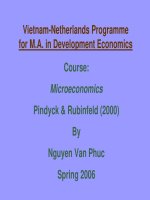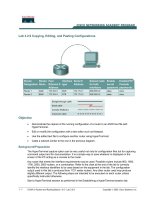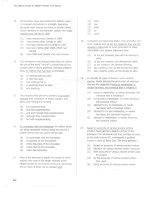Tài liệu Scientif ic Evidence for Musculoskeletal, Bariatric, and Sports Nutrition pdf
Bạn đang xem bản rút gọn của tài liệu. Xem và tải ngay bản đầy đủ của tài liệu tại đây (7.71 MB, 642 trang )
Scientific Evidence
for Musculoskeletal,
Bariatric,
and
Sports Nutrition
This page intentionally left blank
Boca Raton London New York
A CRC title, part of the Taylor & Francis imprint, a member of the
Taylor & Francis Group, the academic division of T&F Informa plc.
Scientif ic Evidence
for Musculoskeletal,
Bariatric,
and
Sports Nutrition
Edited by
Ingrid Kohlstadt, M.D., M.P.H., F.A.C.N.
Published in 2006 by
CRC Press
Taylor & Francis Group
6000 Broken Sound Parkway NW, Suite 300
Boca Raton, FL 33487-2742
© 2006 by Taylor & Francis Group, LLC
CRC Press is an imprint of Taylor & Francis Group
No claim to original U.S. Government works
Printed in the United States of America on acid-free paper
10987654321
International Standard Book Number-10: 0-8493-3724-0 (Hardcover)
International Standard Book Number-13: 978-0-8493-3724-6 (Hardcover)
Library of Congress Card Number 2005052908
This book contains information obtained from authentic and highly regarded sources. Reprinted material is
quoted with permission, and sources are indicated. A wide variety of references are listed. Reasonable efforts
have been made to publish reliable data and information, but the author and the publisher cannot assume
responsibility for the validity of all materials or for the consequences of their use.
No part of this book may be reprinted, reproduced, transmitted, or utilized in any form by any electronic,
mechanical, or other means, now known or hereafter invented, including photocopying, microfilming, and
recording, or in any information storage or retrieval system, without written permission from the publishers.
For permission to photocopy or use material electronically from this work, please access www.copyright.com
( or contact the Copyright Clearance Center, Inc. (CCC) 222 Rosewood Drive,
Danvers, MA 01923, 978-750-8400. CCC is a not-for-profit organization that provides licenses and registration
for a variety of users. For organizations that have been granted a photocopy license by the CCC, a separate
system of payment has been arranged.
Trademark Notice: Product or corporate names may be trademarks or registered trademarks, and are used only
for identification and explanation without intent to infringe.
Library of Congress Cataloging-in-Publication Data
Scientific evidence for musculoskeletal, bariatric, and sports nutrition / edited by Ingrid Kohlstadt.
p. ; cm.
Includes bibliographical references and index.
ISBN 0-8493-3724-0 (alk. paper)
1. Nutrition. 2. Musculoskeletal system Diseases Nutritional aspects. 3. Obesity Nutritional
aspects. 4. Sports Nutritional aspects. I. Kohlstadt, Ingrid.
[DNLM: 1. Musculoskeletal Diseases etiology. 2. Nutrition Disorders complications. 3.
Evidence-Based Medicine. 4. Musculoskeletal Diseases diet therapy. 5. Obesity diet therapy. 6.
Sports physiology. WE 140 S4163 2006]
QP141.S3485 2006
612.3 dc22 2005052908
Visit the Taylor & Francis Web site at
and the CRC Press Web site at
Taylor & Francis Group
is the Academic Division of Informa plc.
DK6006_Discl.fm Page 1 Friday, September 30, 2005 12:29 PM
Preface
Scientists and clinicians who want to broaden their understanding of the muscu-
loskeletal system should read this book, whether their patients are top-placed
marathon runners or persons for whom taking ten steps out of bed is a marathon.
As a society,we are very accustomed to the visible functions of muscle, fat,
bone,and connective tissue. We frequently refer to the musculoskeletal system
when describing a person — frail, strong, brittle-boned,big, lean, short, agile,
muscular, skinny,fit, and so on. Minutes after a child’s birth we proudly announce
those two key musculoskeletal parameters of height and weight.
Contrast what meets the eye to the unseen critical functions of the muscu-
loskeletal system. The human body is a veteran of famine, deprivation, and pro-
creation. In its millennia of experience,maintaining blood pH and temperature,
fueling the brain and vital organs, and defending against foreign invaders have
been afforded top priority and receive minute-by-minute attention. One may think
of it like this: the musculoskeletal system is analogous to a bank account on
which the body draws to satisfy its top priorities. Millions of “transactions” occur
each second and are known collectively as our metabolism. Only if funds are
available does the body maintain muscle for strength, bone for structure, fat for
shape,and connective tissue for motion.
Insufficiency of nutrients for muscle and bone health usually has a gradual
onset. In some circumstances, the process begins in the womb. Then one day,
seemingly out of the blue,the gradual process reveals itself: the favorite jeans are
too tight, the rotator cuff tear does not heal,the small slip results in a hip fracture,
the dentist diagnoses periodontal disease, or the muscle strain does not heal in
time for the last game of the season. Discovering a musculoskeletal weakness can
be as upsetting as finding out that the bank account is not FTC (Federal Trade
Commission) insured. Neither is the musculoskeletal system FTC (fitness and
total conditioning) insured, except with strategic nutrition.
The treatment of musculoskeletal conditions is widely shared among specialties:
• Preventive medicine corrects short-term dips in the musculoskeletal
reserves, while integrative medicine corrects longer-term dips in the
musculoskeletal reserves associated with pathology. Furthermore,
preventive, integrative,functional, holistic, antiaging, complemen-
tary, naturopathic, and alternative medicine practitioners are champi-
oning the transition from an acute health care system to a system of
chronic disease management more inclusive of nutrition.
• Sports, military,aerospace,and occupational medicine anticipate the
extreme environment of their patients, and optimize muscle and bone-
sparing nutrition accordingly.
DK6006_C000_FM.qxd 12/20/2005 8:31 PM Page v
• Pediatricians diligently monitor patients’ growth; abdominal girth,
weight and height are important health indicators at all ages. Early
environments of the womb, infancy,and childhood shape future mus-
culoskeletal health.
• Endocrinologists have identified the pathways that build muscle and
bone and metabolize fat. Adipose tissue is now credentialed as an
endocrine organ. Bariatricians and bariatric surgeons similarly pion
eer
ways to metabolize fat.
• Surgeons pioneer understanding of how nutrition enhances outcomes
and have said,“Repairing a shoulder without muscle is like nailing a
chiffon pie to the wall.” Dentists are surgeons for a uniquely visible
component of the musculoskeletal system. They can identify nutri-
tional deficiencies by keenly observing oral markers on the initial
visit, and dentists are credited for first warning how s
ugar harms bone
(tooth) health.
• Pain management specialists, osteopathic physicians, physical thera-
pists, massage therapists, chiropractors, and acupuncturists have
partnered with nutrition specialists to relieve pain, especially
for
fibromyalgia.
• Life expectancy is increasing, and at the same time degenerative con-
ditions of the muscles, joints, and tissues are beginning earlier.
Consequently,the fields of antiaging medicine and geriatrics both
focus on treating sarcopenia, obesity, osteoporosis, and arthritis.
• Nutritionists work tirelessly to help patients navigate through a dizzy-
ing array of boxes and cans and when needed, voice the verdict
“Th
at’s not food!” Behavioral medicine buttresses the efforts of nutri-
tion specialists; many people who set out to make healthy choices are
thwarted by food cravings, habits, social norms, and marketing
schemes.
• Public health has long advocated good nutrition and identified com-
munity risk factors for practicing clinicians. Food processing tech-
niques and contamination with xenobiotics pose new broad-sweeping
challenges to the musculoskeletal system. Recently, anthropologists
have stepped into public health nutrition with an insightful variation
on the turn of phrase “You are what you eat.”The health of bones
from our evolutionary ancestors coincides with dietary history.
Nutrition has long been the missing link in the daily treatment of the various
musculoskeletal conditions by the health professionals listed above. The often-
stated reason for giving nutrition short shrift is the lack of evidence. Here it is!
This textbook is a reference for the evidence-based integration of nutrition
into medical treatment. It includes the biologic rationale,animal studies, epi-
demiology,clinical trials, ongoing research initiatives, and food industry statis-
tics. Several contributors have privileged and intimate knowledge of the food
vi Preface
DK6006_C000_FM.qxd 12/20/2005 8:31 PM Page vi
industry. Most of us in medicine are not taught how our food is prepared,neither
is the information readily available in our peer-reviewed journals. Dramatic shifts
in food quality in recent decades have led to pervasive and quantifiable shifts in
the very nutrients needed for musculoskeletal health,and provide extremely com-
pelling evidence not customarily found in medical textbooks.
The most important advances in the science of medicine may be those that
enhance the art of medicine. Knowledge of the molecular processes that underlie
chronic disease equips a clinician to help patients walk their unique path back to
health.
Putting nutrition into practice can be straightforward. This textbook explains
how new technology can be integrated. It elaborates on foods and nutraceuticals
with effects similar to medications. Information is organized into 100 tables and
figures designed for easy reference. The text also includes pearls from clinicians
who have achieved world renown for nutritional innovations in fibromyalgia,
sports medicine, extreme environments, osteoporosis, and ob
esity.
This intellectual work generously contributed by 40 scientists and clinicians
seems analogous to a mosaic or impressionist painting; as one steps away from it,
a masterful image of musculoskeletal health emerges.
Ingrid Kohlstadt, M.D., M.P.H., F.A.C.N.
Physician Nutrition Specialist
Preface vii
DK6006_C000_FM.qxd 12/20/2005 8:31 PM Page vii
This page intentionally left blank
About the Editor
Ingrid Kohlstadt, M.D., M.P.H., F.A.C.N. is the founder
and director of INGRIDients, Inc.,which provides nutrition
information to colleagues and consumers. Dr. Kohlstadt
earned her bachelor’s degree in biochemistry at the
University of Maryland and Universität Tubingen in 1989,
and her medical degree at Johns Hopkins University in
1993. Board-certified in general preventive medicine,she
became convinced that nutrition is a powerful and underuti-
lized tool to prevent dis
ease. She therefore continued her
training in nutrition with fellowships at The Centers for Disease Control and
Prevention and at Johns Hopkins.
Dr. Kohlstadt’s clinical work and nutrition consultancies have spanned all
s
even continents and include the U.S. Antarctic Program, Amazon Basin tribes,
Alaskan Inuit, African refugees, displaced persons in the Caucasus, Native
American nations, and Central Asian governments. For her contribution to
medical anthropology,she has been elected to The Explorers Club.
Citing obesity as the primary national nutrition challenge, in 1999 Dr. Kohlstadt
focused her career on the medical,public health, anthropologic, and biochemical
aspects of fat metabolism. She has worked as a bariatric physician at the Johns
Hopkins Weight Management Center and the Florida Orthopaedic Institute.
She currently instructs and conducts research at Johns Hopkins University.
Dr. Kohlstadt has been elected a Fellow of the American College of Nutrition.
DK6006_C000_FM.qxd 12/20/2005 8:31 PM Page ix
This page intentionally left blank
Contributors
Stephen Alway, Ph.D.
Professor and Chair
Division of Exercise Physiology
West Virginia University School of Medicine
Morgantown, West Virginia
Richard A. Anderson, Ph.D.
Nutrient Requirements and Functions Laboratory
Beltsville Human Nutrition Research Ce
nter
Beltsville, Maryland
David J. Baer, Ph.D.
Diet and Human Performance Laboratory
Beltsville Human Nutrition Research Center
Beltsville, Maryland
John D. Bagnulo, Ph.D., M.P.H.
Assistant Professor of Nutrition and Exercise Physiology
University of Maine
Farmington, Maine
Fereydoon Batmanghelidj, M.D.
G
lobal Health Solutions
Vienna, Virginia
Jeffrey S. Bland, Ph.D., F.A.C.N.
Metagenics Inc.
Gig Harbor, Washington
Susan E. Brown, Ph.D., C.N.S.
Director
Osteoporosis Education Project
East Syracuse,New York
Luke R. Bucci, Ph.D., C.C.N., C.N.S.
Weider Nutrition
Salt Lake City, Utah
InnerPath Nutrition
Reno, Nevada
DK6006_C000_FM.qxd 12/20/2005 8:31 PM Page xi
Aileen P. Burford-Mason, Ph.D.
Research Consultant
DRS Consulting
Toronto, Ontario, Canada
See Wai Chan, M.D., M.P.H.
Assistant Professor of Pediatrics,
OB/GYN and Reproductive Sciences
University of Pittsburgh,School of Medicine
Pittsburgh,Pennsylvania
Carlo Contoreggi, M.D.
Intramural Research Program
National Institut
e on Drug Abuse
National Institutes of Health
Baltimore, Maryland
Altoon S. Dweck, M.D., M.P.H.
Johns Hopkins University,Bloomberg School of Public Health
Baltimore, Maryland
Mary G. Enig, Ph.D.
Enig Associates
Silver Spring, Maryland
Kevin Gebke, M.D.
Indiana University Center for Sports Medicine
Indiana University Medical Center
Indianapolis, Indiana
Paula J. Geiselman, Ph.D.
Department of Psychology
Louisiana State University and
Pennington Biomedical Research Center
Baton Rouge,Louisiana
Lawrence B. Godwin, M.Ac., L.Ac.
Virginia Acupuncture
Alexandria, Virginia
Gabriel Keith Harris, Ph.D.
Diet and Human Performance Laboratory
Beltsville Human Nutrition Research Center
United States Department of Agriculture
Beltsville, Maryland
xii Contributors
DK6006_C000_FM.qxd 12/20/2005 8:31 PM Page xii
Tony Helman, M.B. B.S., Dip.Obst. R.C.O.G.,
Mast. Med., D. Hum. Nutr., M.R.A.C.G.P.
School of Health Sciences
Deakin University
Melbourne,Victoria, Australia
School of Public Health,
Curtin University
Perth,Western Australia
Michael F. Holick, Ph.D., M.D.
Section of Endocrinology
Department of Medicine
Boston Un
iversity School of Medicine
Boston, Massachusetts
Russell Jaffe, M.D., Ph.D., C.C.N., N.A.C.B.
Senior Fellow
Health Studies Collegium
Sterling, Virginia
Ian Janssen, Ph.D.
School of Physical and Health Education, and
Department of Community Health and Epidemiology
Queen’s University
Kingston, Ontario, Canada
Vilma A. Joseph, M.D., M.P.H.
Montefiore Medical Center/Albert
Einstein College of Medicine
Weiler Hospital
Bronx, New York
Ingrid Kohlstadt, M.D., M.P.H., F.A.C.N.
INGRIDients, Inc.
Tampa, Florida
and Johns Hopkins University
Baltimore,Meryland
Joseph J. Lamb, M.D.
The Integrative Medicine Works
Alexandria, Virginia
Helyn Luechauer, D.D.S.
Private Practice
Vallejo, California
Contributors xiii
DK6006_C000_FM.qxd 12/20/2005 8:31 PM Page xiii
Wayne C. Miller, Ph.D.
Department of Exercise Science
The George Washington University Medical Center
Washington, D.C.
David I. Minkoff, M.D.
BodyHealth, Inc.
Clearwater, Florida
Laurie Mischley, N.D.
University Health Clinic Specialty Care and Research Ce
nter
Seattle,Washington
David Musnick, M.D.
Bastyr University and University of Washington
Seattle,Washington
Karen Mutter, D.O.
Integrative Medicine Healing Center LLC
Clearwater, Florida
Craig Nadelson, D.O.
Indiana University Center for Sports Medicine
Indiana University Medical Center
Indianapolis, Indiana
Gilberto Pereira, M.D.
Department of Pediatrics
The Children’s Hospital of Philadelphia
University of Pennsylvania School of Medicine
Philadelphia, Pennsylvania
Matthew A. Pikosky, Ph.D., R.D.
Military Nutrition Division
U.S. Army Research Institute of Environmental Medicine
Natick, Massachusetts
Kathryn Poleson, D.M.D., F.A.C.D.
Editor, WAGD Today
Clark College,School of Dental Hygiene
Vancouver, Washington
xiv Contributors
DK6006_C000_FM.qxd 12/20/2005 8:31 PM Page xiv
Arline D. Salbe, Ph.D., R.D.
Research Nutritionist
Obesity and Diabetes Clinical Research Section
National Institute of Diabetes and Digestive and Kidney Diseases
National Institutes of Health
Phoenix, Arizona
Marlene B. Schwartz, Ph.D.
Department of Psychology
Yale University
New Haven, Connecticut
Eric Schweitzer, D.P.T., M.T.C.
Florida Orthopaedics
Tampa, Florida
Kevin R. Short, Ph.D.
Assistant Professor
Endocrine Research Unit
Mayo Clinical College of Medicine
Rochester, M
innesota
Steven R. Smith, M.D.
Pennington Biomedical Research Center
Louisiana State University
Baton Rouge,Louisiana
Jacob Teitelbaum, M.D.
Annapolis Research Center for Effective
CFS/Fibromyalgia Therapies
Annapolis, Maryland
Andrew J. Young, Ph.D.
Military Nutrition Division
U.S. Army Research Institute of Environmental Medicine
Natick, Massachusetts
Contributors xv
DK6006_C000_FM.qxd 12/20/2005 8:31 PM Page xv
This page intentionally left blank
Contents
Section I: Frontiers and Technologic Advances
Chapter 1
Body Composition: Quantifying the Musculoskeletal System . . . . . . 3
Ian Janssen
Chapter 2
Nutrigenomics: Strategic Prevention of
Musculoskeletal Disorders of Aging . . . . . . . . . . . . . . . . . . . . . . . . 27
Jeffrey S. Bland
Chapter 3
Early Environments: Fetal and Infant Nutrition . . . . . . . . . . . . . . . . 43
See Wai Chan and Gilberto Pereira
Section II: Key Nutrients
Chapter 4
Fat . . . . . . . . . . . . . . . . . . . . . . . . . . . . . . . . . . . . . . . . . . . . . . . . 67
Mary G. Enig and Ingrid Kohlstadt
Chapter 5
Carbohydrate . . . . . . . . . . . . . . . . . . . . . . . . . . . . . . . . . . . . . . . . 81
John D. Bagnulo
Chapter 6
Protein . . . . . . . . . . . . . . . . . . . . . . . . . . . . . . . . . . . . . . . . . . . . . 95
David I. Minkoff
Chapter 7
Antioxidants . . . . . . . . . . . . . . . . . . . . . . . . . . . . . . . . . . . . . . . . . 111
Gabriel K. Harris and David J. Baer
Chapter 8
Water: A Driving Force in the Musculoskeletal System . . . . . . . . . . 127
Fereydoon Batmanghelidj and
Ingrid Kohlstadt
DK6006_C000_FM.qxd 12/20/2005 8:31 PM Page xvii
Chapter 9
Magnesium . . . . . . . . . . . . . . . . . . . . . . . . . . . . . . . . . . . . . . . . . . 137
Aileen P. Burford-Mason
Chapter 10
Vitamin D: Importance for Musculoskeletal
Function and Health . . . . . . . . . . . . . . . . . . . . . . . . . . . . . . . . . . . 153
Michael F. Holick
Chapter 11
Chromium: Roles in the Regulation of Lean
Body Mass and Body Weight . . . . . . . . . . . . . . . . . . . . . . . . . . . . . 175
Richard A. Anderson
Section III: Fat Tissue
Chapter 12
Energy Balance . . . . . . . . . . . . . . . . . . . . . . . . . . . . . . . . . . . . . . . 193
Wayne C. Miller
Chapter 13
Neuroendocrine Regulation of Appetite . . . . . . . . . . . . . . . . . . . . . 211
Carlo Contoreggi and Ingrid Kohlstadt
Chapter 14
Estrogen’s Role in the Regulation of Appetite and Body Fat . . . . . . 231
Paula J. Geiselman and Steven R. Smith
Chapter 15
Childhood Obesity . . . . . . . . . . . . . . . . . . . . . . . . . . . . . . . . . . . . 253
Arline D. Salbe, Marlene B. Schwartz,
and Ingrid Kohlstadt
Chapter 16
Bariatric Surgery: More Effective with Nutrition . . . . . . . . . . . . . . . 271
Ingrid Kohlstadt
Chapter 17
Malnutrition: Applying the Physiology of
Food Restriction to Clinical Practice . . . . . . . . . . . . . . . . . . . . . . . 283
Altoon S. Dweck
xviii Contents
DK6006_C000_FM.qxd 12/20/2005 8:31 PM Page xviii
Section IV: Muscle Tissue
Chapter 18
Muscle Atrophy During Aging . . . . . . . . . . . . . . . . . . . . . . . . . . . . 305
Kevin R. Short
Chapter 19
Muscle Strain . . . . . . . . . . . . . . . . . . . . . . . . . . . . . . . . . . . . . . . . 337
Ingrid Kohlstadt,
Eric Schweitzer, Karen Mutter,
and Lawrence B. Godwin
Chapter 20
Muscle Hypertrophy . . . . . . . . . . . . . . . . . . . . . . . . . . . . . . . . . . . 355
Stephen E. Alway
Section V: Soft Tissue
Chapter 21
Osteoarthritis . . . . . . . . . . . . . . . . . . . . . . . . . . . . . . . . . . . . . . . . 391
Laurie Mischley and David Musnick
Chapter 22
Fibromyalgia . . . . . . . . . . . . . . . . . . . . . . . . . . . . . . . . . . . . . . . . . 407
Jacob Teitelbaum
Chapter 23
Gout . . . . . . . . . . . . . . . . . . . . . . . . . . . . . . . . . . . . . . . . . . . . . . . 425
Tony Helman
Chapter 24
Oral Markers of Tissue Health . . . . . . . . . . . . . . . . . . . . . . . . . . . . 431
Helyn Luechauer and Kathryn Poleson
Section VI: Bone
Chapter 25
Bone Nutrition . . . . . . . . . . . . . . . . . . . . . . . . . . . . . . . . . . . . . . . 443
Susan E. Brown
Chapter 26
Osteoporosis . . . . . . . . . . . . . . . . . . . . . . . . . . . . . . . . . . . . . . . . . 473
Joseph J. Lamb
Contents xix
DK6006_C000_FM.qxd 12/20/2005 8:31 PM Page xix
Chapter 27
Fractures . . . . . . . . . . . . . . . . . . . . . . . . . . . . . . . . . . . . . . . . . . . . 491
Craig Nadelson and Kevin Gebke
Section VII: Physical Stress
Chapter 28
Preparing for Orthopedic Surgery . . . . . . . . . . . . . . . . . . . . . . . . . 507
Vilma A. Joseph and Ingrid Kohlstadt
Chapter 29
Xenobiotics: Managing Toxic Metals, Biocides,
Hormone Mimics, Solvents, and Chemical Disruptors . . . . . . . . . . 521
Russell Jaffe
Chapter 30
Ergogenics: Maintaining Performance During Physical Stress . . . . . 545
Luke R. Bucci
Chapter 31
Terrestrial Extremes: Nutritional Considerations for
High Altitude and Cold and Hot Climates . . . . . . . . . . . . . . . . . . . 563
Matthew A. Pikosky and Andrew J. Young
Index . . . . . . . . . . . . . . . . . . . . . . . . . . . . . . . . . . . . . . . . . . . . . . 593
xx Contents
DK6006_C000_FM.qxd 12/20/2005 8:31 PM Page xx
Section I
Frontiers and Technologic
Advances
DK6006_C001.qxd 11/11/2005 2:43 PM Page 1
This page intentionally left blank
CONTENTS
Introduction . . . . . . . . . . . . . . . . . . . . . . . . . . . . . . . . . . . . . . . . . . . . . . . . 3
Body Composition Rules . . . . . . . . . . . . . . . . . . . . . . . . . . . . . . . . . . . . . . 4
Five-Level Body Composition Model . . . . . . . . . . . . . . . . . . . . . . . . . 4
Atomic Level . . . . . . . . . . . . . . . . . . . . . . . . . . . . . . . . . . . . . . . . . . . . 5
Molecular Level . . . . . . . . . . . . . . . . . . . . . . . . . . . . . . . . . . . . . . . . . . 5
Cellular Level . . . . . . . . . . . . . . . . . . . . . . . . . . . . . . . . . . . . . . . . . . . 6
Tissue Level . . . . . . . . . . . . . . . . . . . . . . . . . . . . . . . . . . . . . . . . . . . . 6
Body Composition Methods . . . . . . . . . . . . . . . . . . . . . . . . . . . . . . . . . . . . 6
Measurement Method Principles . . . . . . . . . . . . . . . . . . . . . . . . . . . . . 7
Anthropometry . . . . . . . . . . . . . . . . . . . . . . . . . . . . . . . . . . . . . . . . . . 8
Densitometry . . . . . . . . . . . . . . . . . . . . . . . . . . . . . . . . . . . . . . . . . . . . 12
Bioelectrical Impedance Analysis . . . . . . . . . . . . . . . . . . . . . . . . . . . . 13
Dual-Energy X-Ray Absorptiometry . . . . . . . . . . . . . . . . . . . . . . . . . . 14
Computed Tomography and Magnetic Resonance Imaging . . . . . . . . . 16
Reference Body Composition Data . . . . . . . . . . . . . . . . . . . . . . . . . . . . . . . 17
Children . . . . . . . . . . . . . . . . . . . . . . . . . . . . . . . . . . . . . . . . . . . . . . . . 17
Adults . . . . . . . . . . . . . . . . . . . . . . . . . . . . . . . . . . . . . . . . . . . . . . . . . 19
Summary and Conclusion . . . . . . . . . . . . . . . . . . . . . . . . . . . . . . . . . . . . . . 22
References . . . . . . . . . . . . . . . . . . . . . . . . . . . . . . . . . . . . . . . . . . . . . . . . . 23
INTRODUCTION
A central aspect of the field of nutrition and musculoskeletal health is establishing
the body composition characteristics of humans. This chapter provides an
overview of concepts and methodology related to quantifying human body
composition, particularly as the y pertain to measuring the quantity and distribution
Body Composition:
Quantifying the
Musculoskeletal System
Ian Janssen, Ph.D.
1
3
DK6006_C001.qxd 11/11/2005 2:43 PM Page 3
of fat, fat-free mass (FFM), and the skeleton. This chapter will also briefly
discuss the influence of growth and development, aging, race,and gender on the
musculoskeletal system, and in so doing will set the stage for many of the subse-
quent chapters.
BODY COMPOSITION RULES
F
IVE-LEVEL BODY COMPOSITION MODEL
The human body can be organized into five distinct levels of increasing com-
plexity: atomic, molecular, cellular, tissue,and whole body.
1
Figure 1.1 illustrates
the primary components of the five levels. There are two key concepts of the five-
level body composition model. The first is that components at higher levels are
composed of lower-level components. Consider, for example,adipose tissue,a
tiss
ue level component that includes (but is not limited to) adipocytes at the
cellular level, lipids at the molecular level,and carbon at the atomic level.
The second key concept of the five-lev el body composition model is the exis-
tence of relations among components that are relativ ely constant within a given indi-
vidual over time (e.g.,before and after weight loss) and among different indi viduals
(e.g.,similar in overweight and lean individuals). For instance,there is a relati v ely
stable relation between total body water at the atomic level and FFM at the molec-
ular level (FFM ϭ total body water ϫ 1.37).
2
The existence of these stable rel a-
tions is fundamental to the body composition field as they allow investigators to
estimate an unknown component based on a measured component. Thus, in the
4 Scientific Evidence for Musculoskeletal, Bariatric, and Sports Nutrition
FIGURE 1.1 Five-le v el body composition model. (Adapted from Wang, Z.M.,Pierson, R.N.,
Jr.,and Heymsfield,S.B., Am. J. Clin. Nutr., 56, 19–28, 1992.)
DK6006_C001.qxd 11/11/2005 2:43 PM Page 4









